
All iLive content is medically reviewed or fact checked to ensure as much factual accuracy as possible.
We have strict sourcing guidelines and only link to reputable media sites, academic research institutions and, whenever possible, medically peer reviewed studies. Note that the numbers in parentheses ([1], [2], etc.) are clickable links to these studies.
If you feel that any of our content is inaccurate, out-of-date, or otherwise questionable, please select it and press Ctrl + Enter.
Migraine pills
Medical expert of the article
Last reviewed: 03.07.2025

Migraine is a neurological disorder that is more common in women. There is no specific explanation for why a migraine attack occurs in a particular patient. Scientists have been able to establish that it is a chronic vascular disease, but it is not caused by trauma, stroke or other diseases of this kind.
A migraine attack varies from minor to very severe. During headaches, a person may partially or completely lose their ability to work. Migraine pills are considered an excellent way out of this situation. They will partially or completely help relieve pain and spasms. When choosing a suitable drug, be sure to consult a doctor, self-medication can only do harm.
It is noted that migraine attacks in different people recur with different frequency and intensity. The mildest form is mild headaches a couple of times a year. A more typical option is from 2 to 8 times a month. If you belong to the first group, then you may not need pills. But in the second case, you cannot do without a painkiller.
Indications for use
Indications for the use of tablets are suitable for almost all patients. The only exceptions are those whose attacks are accompanied by particularly severe headaches and some mental factors. Tablets can be prescribed:
- If migraine is not caused by brain injury, stroke, or brain disease.
- If migraine is not caused by changes in atmospheric and arterial pressure.
- If migraine attacks are not particularly severe.
The tablets relieve pain, significantly improving well-being. They are not recommended for pregnant women and during lactation. It is necessary to evaluate their benefits and possible harm to the child. But the best solution would be to get rid of headaches with natural remedies or herbal infusions
Pharmacodynamics
Pharmacodynamics studies the effect of a drug on the human body. This is very necessary in the development of drugs for migraines. Many of them have many side effects. Pharmacodynamics allows you to determine the level of risk and benefit from taking the drug.
This area of pharmacology studies the full cycle of a drug's stay in the human body, from intake to elimination. Almost all potent migraine drugs are eliminated from the body for a very long time, more than a day. Migraine drugs begin to act quite quickly, from 15 minutes to an hour. But at the same time, they can be eliminated for several days, gradually with urine. It is also possible to determine the maximum effect of the drug on the body, identify the most effective periods and periods of occurrence of side effects.
All tests performed help determine the level of accumulation of a particular component in individual organs and the possible risk of excessive use. This helps determine the maximum dosage and recommended frequency of administration.
Pharmacokinetics
Pharmacokinetics is very similar to pharmacodynamics. Only this science deals exclusively with determining all the processes that occur with the drug after it enters the body. Pharmacokinetics is divided into several stages:
- Absorption. After taking the medicine, it is absorbed into the walls of blood vessels and enters the blood. After that, it begins to act and has the desired effect. Absorption occurs faster with injections, the tablet must first dissolve.
- Distribution by tissues and organs. The medicine gets to those organs on which it should act favorably. It also gets to organs on which it can act destructively.
- Metabolism. Each drug has its own elimination process. It depends on the liver and kidneys. The drug is eliminated most quickly with urine, which is why when taking antibiotics, urine may have a specific smell and an atypical color.
- Excretion. The body can excrete drugs with sweat, saliva, milk. The faster the drug dissolves and is processed, the faster its excretion begins in all possible ways.
The most popular migraine pills
When choosing a drug, it is necessary to take into account the patient's age and health, allergies and poor tolerance to the components of the drug. In women, headaches pass faster than in men, although in men migraines occur several times less often.
Excedrin
Description: The tablets contain paracetamol, salicylic acid and caffeine. Paracetamol relieves pain and stops the inflammatory process, but very gently. Salicylic acid has a stronger effect. It relieves inflammation, a feeling of heat and relieves pain. Caffeine has a tonic effect and improves the transmission of impulses in the spinal cord.
Indications: used to relieve various types of pain. This includes headaches and toothaches, mild to moderate migraines, and menstrual pain.
Dosage: The drug can be taken by children over 15 years of age. Take 1 tablet with food or after food. Regularity of administration - 4-6 hours. When a migraine begins, take 2 tablets at once. The maximum number of tablets per day is 6 pieces. The drug begins to act in 15 minutes, and in case of migraine in 30 minutes. The drug can be taken for no more than 5 days, in case of migraine only 3 days.
Contraindications: hypersensitivity to some drugs, gastrointestinal disorders, asthma, intolerance to salicylic acid, glaucoma, renal failure. Pregnancy and lactation, excitability, children under 15 years of age. It is not recommended to take simultaneously with drugs containing salicylic acid or any other painkillers and antipyretics.
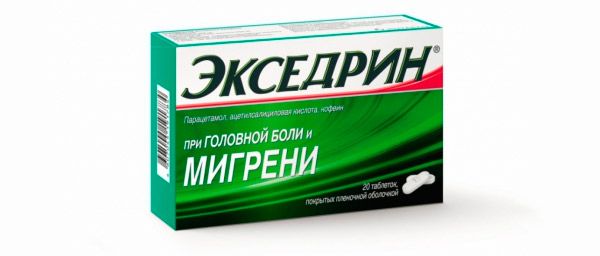
Side effects: the drug has a number of side effects that you should be familiar with before taking it. These include nausea, vomiting, gastrointestinal tract damage, allergic rashes, increased heart rate, and increased blood pressure. If the drug is taken for a long time, it can cause headaches and dizziness, visual impairment and tinnitus, nosebleeds, and liver dysfunction.
Sumamigraine
Description: Sumamigren acts on blood vessels and serotonin. It stimulates serotonin receptors, causing vasoconstriction. This is the principle of action of the drug. It very gently and for a long time relieves migraine headaches. It is excreted from the body in a couple of hours.
Indications: Migraines of varying intensity. This is a drug that is narrowly targeted at a specific complication. It begins to act in 30 minutes, and its maximum concentration in plasma is observed after 45 minutes.
Dosage: Take 1 tablet orally without chewing, wash down with water. If the migraine attack is very strong, you can take 2 tablets. If the pain has not decreased and continues with the same intensity, you should not take the drug. In the future, it can be taken as a remedy for migraines. It is recommended to take 1 tablet per day (for mild headaches), up to 6 tablets per day maximum (if the pain is very strong).
Overdose: When taking more than 8 tablets per day, no obvious side effects have been identified. It is necessary to constantly monitor the patient for at least 10 hours, periodically conducting a therapeutic examination.
Contraindications: pregnancy and lactation. Breastfeeding should not be performed earlier than 24 hours after taking the drug.
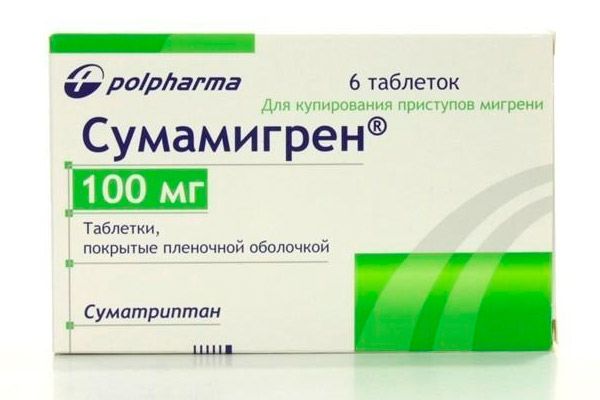
Side effects: dizziness, drowsiness, very rarely convulsions, decreased visual acuity, black spots before the eyes, partial loss of vision, increased blood pressure, hot flashes. In very rare cases, tachycardia, heart rhythm disturbances, decreased blood pressure are observed. Nausea, vomiting, very rarely, a feeling of discomfort in the abdomen, a feeling of heaviness that can occur in any part of the body, including the chest and throat, shortness of breath, a burning sensation in the nose and throat, nosebleeds.
Relpax
Description: Relpax has a vasoconstrictor effect, due to which a migraine attack is stopped. It affects serotonin and neuronal vascular receptors. The drug begins to act after 30 minutes. It is excreted from the body after a couple of hours. The patient's gender does not matter. In elderly people, the effect of taking the drug is slightly reduced, compared to young adult men and women.
Indications: The drug has a relieving effect on migraine attacks.
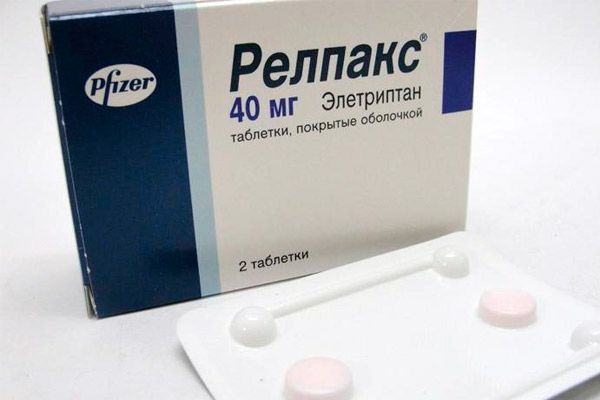
Dosage: The drug can be taken by patients aged 18 to 65 years. The tablet is taken orally, without chewing and with clean water. It is advisable to start taking Relpax as soon as an attack begins. But at later stages, the drug is also very effective. You need to take 1 tablet per day. If the pain intensifies or does not go away, you can take another tablet, but only after 2 hours. According to research, if the migraine does not go away within 2 hours, then further treatment with this drug should be postponed. Relpax can be used in the future, but the dose should be increased to 2 tablets. The maximum amount per day is 4 tablets.
Overdose: In case of overdose, the stomach should be washed and the patient should be observed for at least 20 hours, with periodic therapeutic examination. Cardiovascular disorders may also occur.
Contraindications: It is not advisable to take the drug during pregnancy. It is prescribed only when the benefit from it exceeds the harm to the child. Taking 2 tablets during lactation is possible once. But feeding should be postponed for 24 hours.
Side effects: the drug is well tolerated by the body, but a number of side effects have been noted, such as rhinitis, pharyngitis, throat tightness. Rarely, yawning, changes in the timbre of the voice, respiratory infections, anorexia, insomnia, impaired consciousness, confused thinking, depression, dizziness, headaches, drowsiness, tachycardia, bradycardia, increased blood pressure, shock, nausea, abdominal pain may occur. Sometimes dry mouth, belching, swelling of the tongue, constipation, diarrhea, rashes, itching, urticaria, increased sweating may occur.
Zolmigren
Description: The drug is intended to eliminate migraine attacks of varying severity and intensity. It can be used as an independent drug or in combination (in the treatment of a severe attack lasting 2-5 days). It shows good results as a means of eliminating migraines during menstruation. It helps to minimize nausea and vomiting, irritability from noise and light.
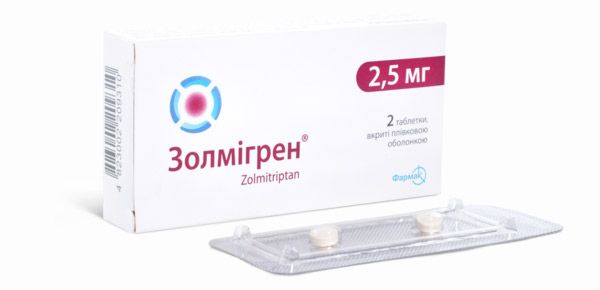
Indications: relieves migraine attacks with and without aura (the patient’s reaction to noise, light, voice and other mental disorders).
Dosage: The drug is not a preventive measure against migraine. It should be taken as soon as possible after the attack begins. Adults are recommended to take 1 tablet per day. If the attack does not stop or reoccurs again, another tablet can be taken after 2 hours. Then, 2 tablets can be taken at once. The maximum daily dose is 6 tablets. With severe liver dysfunction, the maximum dose is 2 tablets per day.
Overdose: There is no data on overdose. Volunteers who took a single dose of 50 mg (20 tablets) experienced sedative-type disorders. It is necessary to wash out the stomach as quickly as possible, monitor the cardiovascular system. There is no antidote.
Contraindications: severe forms of liver dysfunction, angina pectoris and other cardiovascular diseases, children and people over 65 years of age.
Side effects:
- Digestive system – nausea, dry mouth.
- Nervous system – dizziness, headache, drowsiness, feeling of constriction in the throat, impaired sensitivity.
- Musculoskeletal system - muscle weakness.
- Others: hot flashes, feeling of warmth, asthenia.
All side effects are mild, do not recur in the same way when the drug is taken again, and disappear without medical assistance.
Sedalgin
Description: Sedalgin acts primarily on the nervous system. The components of the drug have an antipyretic and analgesic effect. Caffeine, which is part of the composition, has an analgesic and relaxing effect, however, the ability to tone the nervous system is weakly expressed. It begins to be excreted by the body after 1.5 hours.
Indications: a drug for the relief of short-term and systematic pain of various natures. Sedalgin is effective for headaches and toothaches, post-traumatic and post-burn pain, pain in the joints and muscles.
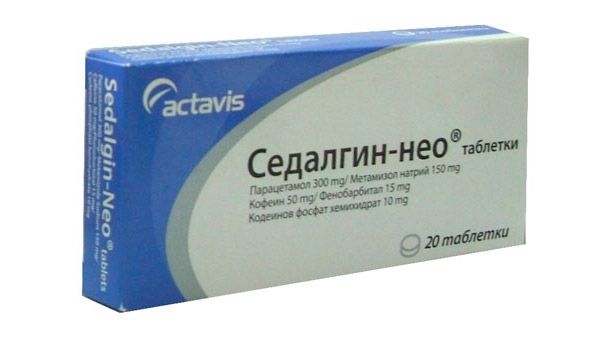
Dosage: Adults and children over 14 years of age are recommended to take 1 tablet during meals. Wash down with clean water. Take 3-4 tablets per day. The maximum single dose is 2 tablets, daily – 6 tablets. The course of treatment is 3 days.
Overdose: Overdose may cause dizziness, disorientation, delirium, depersonalization, drowsiness, fainting, nausea, vomiting. Renal and hepatic failure may also develop. In this case, gastric lavage and activated charcoal administration are necessary.
Contraindications: Hypersensitivity to some components. Also, the drug should not be taken by people with bronchial asthma, gastric ulcer and duodenal ulcer, myocardial infarction, arrhythmia, severe forms of renal and hepatic insufficiency, pulmonary insufficiency, anemia, traumatic brain injury, during pregnancy and lactation, children under 14 years of age.
Side effects: The drug is well tolerated, all side effects disappear on their own after discontinuation of use. But in some cases, the patient may experience the following negative reactions:
- Allergic rashes, urticaria, itching, Quincke's edema;
- Nausea, vomiting, constipation or diarrhea;
- Drowsiness, sleep disturbances, rapid fatigue, dizziness, impaired coordination, irritability, sudden mood swings. The drug causes addiction and drug dependence;
- Visual impairment, tinnitus;
- Tachycardia, bradycardia, chest pain;
- Urination disorder, urine coloration red;
- Sweating, shortness of breath.
Amigrenin
Description: Amigrenin affects receptors located in the cells of the arterial vessels of the brain. This leads to their stimulation. It also affects the trigeminal nerve. Due to this effect, headache or migraine goes away after 30 minutes.
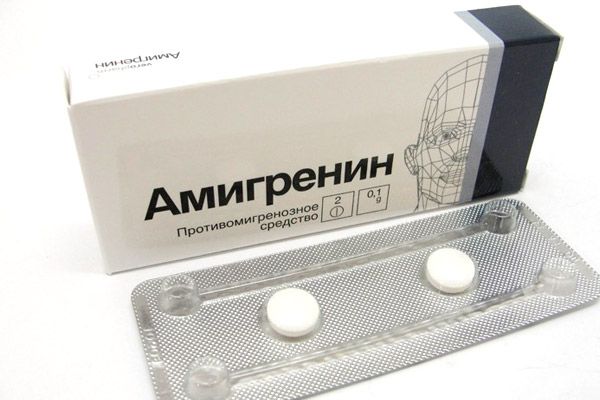
Indications: relief of all types of migraine, with aura (reaction to all external stimuli) and without aura.
Dosage: The drug can be taken by children over 18 years of age and elderly people up to 65 years of age. A single dose is 1 tablet. It should be swallowed whole, without chewing. Wash it down with clean water. A single dose can be increased to 2 tablets. If the drug does not work, you should stop using it in the future. If the migraine has passed, but then resumed within 24 hours from the moment of taking the first dose, subsequent doses of tablets (1 tablet) can be repeated no earlier than 2 hours later. A maximum of 6 tablets are taken per day.
Overdose: There is no data on the patient's well-being in case of overdose. It has been established that in such a case the risk of side effects will increase. But in case of excessive intake of the drug, the patient must be observed for at least 10 hours, conducting a therapeutic examination.
Contraindications: the drug is contraindicated in case of allergic reactions after the first dose, patients after myocardial infarction, with cardiac ischemia, circulatory disorders in the heart muscle, blood pressure surges (especially if they are difficult to treat and uncontrollable), cerebral atherosclerosis (cholesterol deposition and plaque formation in the vessels of the brain), renal and hepatic insufficiency. The drug should not be taken during pregnancy and lactation, by children under 18 years of age and people over 65 years of age.
Side effects: Irregular heartbeat, arrhythmia or bradycardia, poor circulation in the legs (Raynaud's syndrome), blurred vision, nausea, vomiting, abdominal pain, liver cell damage, weakness, drowsiness, fatigue, dizziness, skin rashes.
Sumatriptan
Description: the drug acts exclusively on the vessels of the brain and trigeminal nerve. It leads to stimulation and narrowing of these vessels. It is quickly absorbed and begins to act after 30 minutes.
Indications: Sumatriptan completely eliminates all symptoms of migraine with or without aura (reaction to all external stimuli).

Dosage: The drug is taken orally without chewing. Wash it down with clean water. The effect of the tablet will be faster and more effective if you take it at the earliest stage of a migraine attack. You can take no more than 2 tablets at a time. If the drug does not work, do not use it further. If the drug works, but the pain returns within 24 hours after taking it, you can take another tablet, but not earlier than 2 hours later. The maximum daily dose is 6 tablets.
Overdose: No symptoms other than side effects were observed when taking 8 tablets per day. A therapeutic examination of the patient is necessary.
Contraindications: not recommended for patients after myocardial infarction, with symptoms of coronary heart disease, uncontrolled blood pressure surges (arterial hypertension), stroke, cerebrovascular accident, renal and hepatic insufficiency. Simultaneous administration with ergotamine and its derivatives no earlier than 24 hours later. Patients under 18 and over 65 years old, pregnancy and lactation, epilepsy (with caution).
Side effects: dizziness, drowsiness, decreased sensitivity, hot flashes, increased blood pressure shortly after taking the drug, irritation of the nasal mucosa, nosebleeds, nausea, vomiting, a feeling of pressure in different parts of the body.
Zomig
Description: the drug causes vasoconstriction and slows down the release of neuropeptides, which allows you to quickly stop a migraine attack. In addition, the drug helps to reduce all the unpleasant symptoms - nausea, vomiting, phono and photophobia. The peculiarity of Zomig is that it is effective when used repeatedly to stop a migraine attack in one patient. Zomig begins to act 1 hour after taking it.
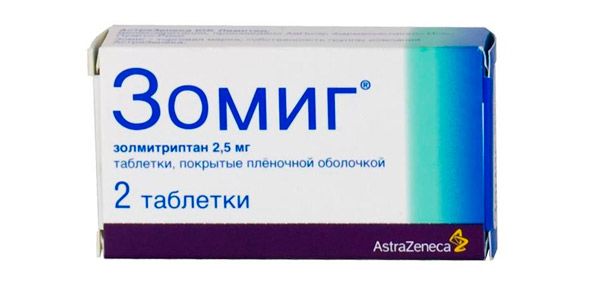
Indications: Relief of migraine attacks of any intensity with or without aura.
Dosage: Take 1 tablet of the drug orally, without chewing, with water. The effect of the drug does not depend on how soon the patient took it from the onset of a migraine attack. The maximum single dose is 2 tablets. The drug can be taken again no earlier than 2 hours later (1 tablet). It is recommended to take no more than 4 tablets per day. Patients with liver and kidney failure can take 2 tablets per day.
Overdose: Sedative effect. It is necessary to monitor the patient's condition for at least 15 hours, maintain the work of the cardiovascular system, control breathing and ventilation of the lungs.
Contraindications: uncontrolled surges in blood pressure, coronary heart disease, angina pectoris, cerebrovascular accident, use with ergotamine and its derivatives, hypersensitivity to the components of the drug, pregnancy and lactation (with caution), people over 65 years of age (no studies have been conducted).
Side effects: the drug is well tolerated, adverse reactions occur within 4 hours after administration and disappear without medical care. Dizziness, stiffness in the neck, chest, decreased sensitivity, drowsiness, weakness, feeling of heaviness, nausea, dry mouth, abdominal pain, tachycardia, angina, palpitations, frequent urination, rashes, swelling, urticaria may occur.
Paracetamol
Description: the drug has an antipyretic and mild analgesic effect. It is quickly absorbed into the digestive tract. It begins to be excreted from the body after 2-4 hours, and in patients with liver failure - after 8-10 hours.
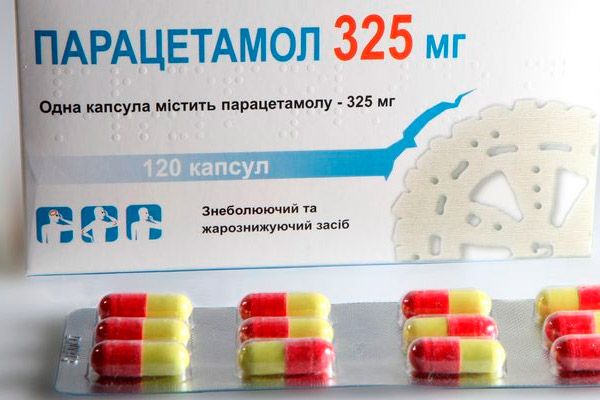
Indications: used to relieve pain of varying intensity and origin – toothache, migraine, menstrual pain, burns and injuries. Suitable for infectious pain.
Dosage: Tablets are taken orally with clean water. Children from 3 months - at a rate of 10 mg / kg of body weight. Children from 6 to 12 years old - 0.5 or 1 tablet 4 times a day. Children over 12 years old and adults - 1-2 tablets 4 times a day.
Overdose: exacerbation of adverse reactions. When taking 10-15 g, there is a risk of liver necrosis.
Contraindications:
- Chronic alcoholism.
- Pregnancy (1st trimester).
- Hypersensitivity to paracetamol.
- Anemia.
- Severe impairment of liver and kidney function.
Side effects: the drug is well tolerated. Rarely, skin rashes, itching, urticaria, liver and kidney dysfunction, aggravation with anemia occur.
Citramon
Description: The components of Citramon complement each other's action. The drug has an analgesic, antipyretic and anti-inflammatory effect. Salicylic acid relieves pain, temperature, caffeine tones the blood vessels of the brain, paracetamol acts at the site of pain and quickly relieves it. The maximum effect of the drug in the body is observed after 2 hours.
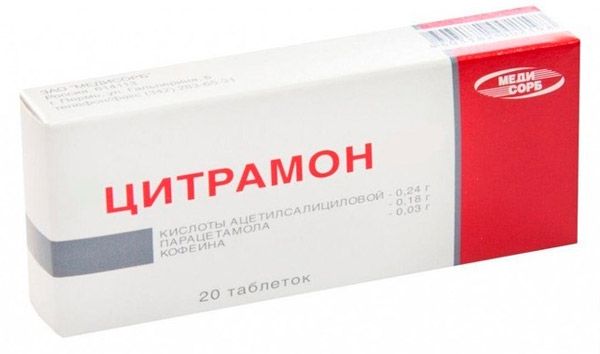
Indications: the drug is an anti-inflammatory and antipyretic agent. It is prescribed for headaches and toothaches, migraines, neuroses, rheumatism.
Dosage: the drug is not prescribed to children. Take 1 tablet orally after meals with clean water. No more than 2-3 tablets per day. It is recommended to take up to 6 tablets, dividing them into 3 doses. The course of treatment should not exceed 10 days.
Overdose: Overdose may cause skin reactions, rash, gastrointestinal bleeding.
Contraindications: Citramon is usually well tolerated and does not cause any negative reactions. But it should be taken with caution by patients with diseases of the duodenum and stomach, liver and kidney failure, pregnant women in the first 3 months of pregnancy, during lactation.
Side effects: they are similar to the side effects of paracetamol and salicylic acid. Namely, allergic rashes, lesions of the stomach and duodenum, exacerbation of asthma. Sometimes there may be a feeling of heat, nausea.
 [ 7 ]
[ 7 ]Analgin
Description: The drug has antipyretic, anti-inflammatory and analgesic properties. Its components inhibit the development of pain and inflammatory reactions in the body. It also increases the pain threshold and reduces the sensitivity of the brain to pain. It begins to act 20-40 minutes after taking, the maximum effect is achieved after 2 hours.
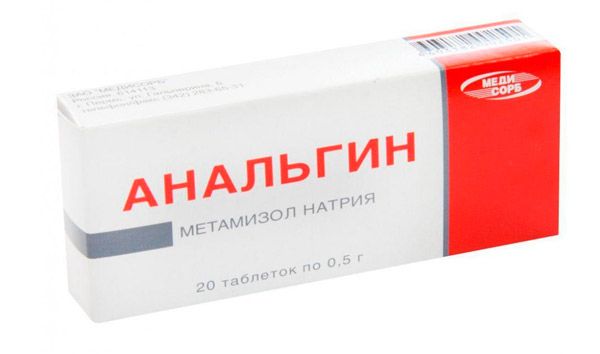
Indications: for pain syndromes caused by headaches, toothaches, migraines, neuralgia, radiculitis, muscle colic. Prescribed as a pain reliever after surgery and a strong antipyretic.
Dosage: Take the tablets according to the instructions after meals with clean water. The drug is allowed to be taken by children from 10 years old. From 10 to 14 years old - 1 tablet. The maximum per day can be taken 4 tablets. Children from 14 years old and adults can take 1 tablet 3 times per day. The maximum per dose can be 2 tablets. During the day, you can take no more than 8 tablets.
Overdose: When taking the drug for more than 7 days in high doses, patients may experience shortness of breath, dizziness, nausea, vomiting, tachycardia, increased blood pressure, tinnitus, renal or hepatic failure.
Contraindications:
- Hypersensitivity to the components of the drug.
- Bronchial and "aspirin" asthma.
- Suppression of hematopoiesis.
- Renal and hepatic failure.
- Bronchospasms.
- Blood diseases.
- Anemia.
- Pregnancy 1 trimester and last 6 weeks.
- Lactation.
- The drug should be given to children under 3 months of age with caution and in small doses.
Side effects: headaches, dizziness, fever, decreased blood pressure, skin rashes, anemia, deterioration of liver function, hepatitis.
Ibuprofen
Description: the drug has analgesic, antipyretic and anti-inflammatory properties. It inhibits the production of prostaglandins, which have a negative effect on the blood vessels of the brain. It gently and effectively acts on the source of pain and relieves it.

Indications: for various pain syndromes (toothache, headache, migraine), rheumatism, fever and inflammatory processes during infectious diseases, as an auxiliary analgesic in therapy.
Dosage: Ibuprofen is taken in the morning on an empty stomach with water. During the day, it is taken after meals. Children aged 6 to 12 years are recommended to take 1 tablet 4 times a day. The interval between doses should be at least 6 hours. The drug can be taken by children weighing more than 20 kg. The daily dose is 30 mg / kg. Adults and children are recommended to take 1 tablet 3-4 times a day. If necessary, a single dose can be increased to 2 tablets. The maximum dose is 6 tablets per day. It should be divided into 3 doses. Without consulting a doctor, the drug can be taken for no longer than 5 days.
Overdose: it can be expressed by abdominal pain, tinnitus, dizziness, drowsiness, pressure surges, increase and decrease of pulse. In case of overdose, it is necessary to immediately wash out the stomach, take activated carbon (only within an hour after the overdose), give the patient an alkaline drink and monitor the general condition.
Contraindications: hypersensitivity to the components of the drug, gastric and duodenal ulcers, colitis, asthma, impaired color vision, impaired liver and kidney function, children under 6 years of age.
Side effects: nausea, vomiting, dizziness, constipation, diarrhea, gastrointestinal disorders, drowsiness, insomnia, excitability, skin rashes, flatulence.
Method of administration and dosage of migraine tablets
The method of application and dosage of migraine tablets is determined by the doctor. Otherwise, it is better to follow the instructions. Self-medication and independent determination of dosage should not be done. The instructions indicate cases of overdose with negative reactions, so you need to do gastric lavage.
Most migraine tablets are taken once a day. If the pain returns, you can take another dose, but only after 2 hours. This can be explained by the fact that after 2 hours the medicine begins to be excreted from the body, it does not accumulate in organs and tissues. The risk of causing harm is not so great.
The maximum daily dose is 4 to 8 tablets. However, it is advisable not to exceed the indicated dose. Otherwise, you can cause severe damage to your kidneys and liver. Almost all medications can be taken again if pain returns. However, during one migraine attack, you should stop taking the tablets if they do not work and start taking others. Next time, you can return to the first option.
Migraine Prevention Tablets
Migraine prevention pills are needed only when the attack reoccurs a couple of times a month and can last up to 12 hours. This prevents the patient from living and working fully. In such cases, drugs can be prescribed to prevent the occurrence of migraines.
The following medications can be recommended: Anaprilin, Obzidan (adrenoblockers); Simbalta, Ixel (antidepressants); Gabagamma (anticonvulsant); Nifedipine (blocks calcium channels). There are also a number of other modern medications that act longer and have fewer side effects.
All medications act for a long time. They are used regularly to achieve complete or partial relief from migraine. Some of them help to get rid of migraine in 1 month. Some – in 6 months. That is why it is so important to choose the right medication. It should not cause strong side effects in the body, should not be addictive and should not negatively affect coordination of movements.
Using migraine pills during pregnancy
Like any medicine, migraine pills are not recommended for use during pregnancy. The active ingredients reach not only the site of pain, but also other tissues and organs. This is not always safe for the fetus. Especially in the early stages of pregnancy. This can lead to developmental delays, a detrimental effect on the developing organs and systems of the child.
Using migraine pills during pregnancy is also unsafe because you can't tell in advance how your body will react. Some components that were previously harmless may have an effect that is completely opposite to what you expected. In addition, the risk of side effects is much higher.
It is necessary to take pills with special caution and only on the recommendation of a doctor. It is better to divide the doses in half so that possible negative effects are minimal. It is also worth postponing drug treatment until the postpartum period, resorting to traditional medicine recipes. There are also a number of products that help reduce pain during a migraine attack.
Migraine pills during lactation
- Paracetamol. This drug is recommended as one of the few for migraine during lactation. It has been verified that only 20% of active components enter breast milk. There is no negative data on the effect of paracetamol and its derivatives on infants. It should be taken immediately after feeding, after 2 hours it will gradually be excreted.
- Ibuprofen. The drug is completely harmless to the baby. Only 0.7% of the drug gets into the milk. There is no data on the negative impact on the child. To further reduce the drug getting into the milk, take it immediately after feeding. It will act quickly and will also quickly begin to be excreted from the body.
- Naproxen. This non-steroidal drug is considered completely harmless to the baby. It is compatible with lactation. However, during the entire period of taking the drug by nursing mothers, there was a single case when the newborn began bleeding and anemia. Take the drug immediately after feeding or replace it with Ibuprofen.
- Citramon. Citramon is considered one of the safest options for migraine medications during lactation. It can be used during this period only when there is no other drug. It should be taken once. The components can cause regurgitation, bleeding and excitability of the child. A milder form is Citramon Extra, which does not contain analgin, but has more caffeine.
Contraindications for use
Almost all migraine pills have contraindications. The liver and kidneys suffer the most, because they are responsible for removing the drug. Therefore, patients with liver and kidney failure should take any chosen drug with special caution.
All medications also have age restrictions. Many of them are not recommended for children and the elderly. Children have weak body protection against harmful components, so the risk of side effects is high. In the elderly, all processes take longer and slower, so the medication may not work as well. The load on the heart, kidneys, and stomach increases.
People with various problems with the cardiovascular system, nervous system, vision, hypersensitivity to some components should also choose drugs very carefully. It is better to choose less effective ones, but with fewer contraindications. Any migraine pills will work, only the simpler ones have a soft and not instant effect.
Side effects
The more effective the drug or the cheaper the raw materials, the more side effects it has. Also, a large list of possible negative reactions indicates that the drug has been well and thoroughly studied. It is imperative to focus on the state of health and the body as a whole.
In general, side effects are clearly expressed in the most important systems and organs of a person. Some drugs with a quick action can harm the eyes, lungs, gastrointestinal tract, blood circulation in the brain. Therefore, be sure to consult a doctor to assess the disadvantages and advantages of the chosen drug.
Side effects of many migraine pills are often expressed within a few hours after taking them. In most cases, they go away on their own without medical assistance. But if the drug has caused some negative reaction in the body, it should be replaced with a more gentle one.
If the list of side effects includes some that match the patient's disease, the medicine should be taken very carefully and in a minimal dose. Choose those tablets that indicate a fast elimination period and a small dosage.
Overdose
During an acute migraine attack, you can take an extra dose of tablets. In case of overdose, you should resort to the following:
- Perform a gastric lavage and take the required dose of activated charcoal:
- Monitor the patient's well-being. Depending on the drug, it is necessary to monitor the patient's well-being for 10 to 20 hours.
- Conduct a therapeutic examination:
- Provide assistance to the functioning of the cardiovascular system and respiratory organs.
Overdose is dangerous because it will certainly affect the liver and kidneys. Patients with renal and hepatic insufficiency are especially susceptible to this phenomenon. The maximum dose for such people is a single double dose for a healthy person.
Overdose can aggravate all side effects. If this may not happen with normal intake, then with overdose this phenomenon is especially common. Abusing pills is also dangerous, because they can cause addiction and dependence. And this is much worse than the initially relieved migraine.
Interaction with other drugs
Almost all migraine pills have a bad interaction with other drugs. This can be explained by the fact that the components of the drug penetrate many tissues and organs, the presence of other active substances there can cause a reversal reaction. In addition, this is a very large burden on the kidneys, liver, heart and brain.
It is recommended to take other drugs only after 24 hours. Then the migraine medicine will be completely or partially eliminated from the body. Its effect will not be as strong. The concentration in all tissues, organs and secreted fluids will also be minimal. The drugs will not overlap each other's action and accumulate in the body.
Migraine pills can be taken together with natural medicines on a natural basis. But not alcohol. Alcohol puts additional stress on the kidneys and liver. In patients with renal and hepatic insufficiency, this can lead to damage to tissues and organs. Tonic and stimulant drugs should be taken with special caution.
Storage conditions
Storage conditions for all migraine pills are approximately the same. Any pill cannot withstand direct sunlight. The structure and active ingredients begin to lose their properties and deteriorate. The recommended storage temperature is from 10 to 25 degrees. But on a hot day, it is better to put them in a cool place. Often, all medications can be stored in the refrigerator. The temperature there is optimal for tablets, capsules, suppositories, ointments and creams.
Make sure that small children cannot find the pills. Many cases of overdose occur due to carelessness of parents. It is better to store all medications on the top shelves, in lockable cabinets or on the lowest and least noticeable shelves in the refrigerator.
The room or storage area must be well ventilated and dry. Otherwise, the packaging may become damp and the medicine may spoil. It is best to store all tablets in the package with instructions. Then at any time you can read the instructions and find out whether the drug is still good.
Best before date
The tablets should be stored in their original packaging and for as long as recommended in the instructions. The expiration date is recommended, but many drugs and ointments can be used for several months after the date of sale. Be sure to ask your doctor about this.
Typically, the shelf life is 2 to 3 years. The tablets should be in a whole blister or a tightly closed box with a lid. Many drugs have an expiration date written on the box and on the packaging with the tablets.
The manufacturer sets the expiration dates based on the tests and studies conducted. Stronger drugs should not be used after the expiration date. They may not work completely or not work at all. Then you will need to take other drugs, and the harm to the body will be doubled.
Effective migraine pills
- Askofen-P. This is a combination remedy for headaches, which includes paracetamol, salicylic acid and caffeine. Paracetamol perfectly relieves pain syndromes, salicylic acid helps with throbbing pain, and caffeine tones and normalizes blood pressure in the brain. They are responsible for reducing headaches.
- Solpadeine. The drug consists of codeine, caffeine and paracetamol. Codeine is considered one of the strongest painkillers, it is listed in the medical reference book as a narcotic. Caffeine helps paracetamol act more effectively, due to which the effect of the drug is prolonged. It is prohibited for pregnant women and during lactation.
- Pentalgin. The components of the drug have an effective effect on the source of pain, relieve spasms, relieve pain and have an anti-inflammatory effect. The drug also has a weak sedative effect.
- Naproxen. This is one of the simplest, but highly effective drugs. It consists of only one component, but has excellent pain-relieving properties. Recommended for migraines of varying intensity, virtually harmless. Very similar in action to Ibuprofen.
How to get rid of migraines without pills?
How to get rid of migraines without pills? This question is relevant for many people with this disease, especially during pregnancy and lactation. It is worth noting that many products that almost everyone has at hand help eliminate headaches. For example, strong black tea and dark chocolate. They normalize the pressure in the blood vessels of the brain and tone them.
If possible, turn off the lights in the room and turn off all sound sources. If this is not possible, insert earplugs into your ears. Lie down horizontally on the bed and completely relax all muscles. Stay in this position until the pain completely disappears.
Apply menthol ointment to your temples. Then bandage your head tightly. Lie down on your bed or sit in a chair. You need to stay with the bandage and in a state of rest until the pain disappears. A good remedy is also considered to be a calm, deep sleep.
You can take a hot bath. Dip not only your body, but your head too. The water should be hot. This method is not suitable for heart and vascular diseases. You can also make hand baths. The water should be very cold, with pieces of ice. Put your hands in the water up to the wrists and hold them there until the water becomes warm.
Attention!
To simplify the perception of information, this instruction for use of the drug "Migraine pills" translated and presented in a special form on the basis of the official instructions for medical use of the drug. Before use read the annotation that came directly to medicines.
Description provided for informational purposes and is not a guide to self-healing. The need for this drug, the purpose of the treatment regimen, methods and dose of the drug is determined solely by the attending physician. Self-medication is dangerous for your health.

